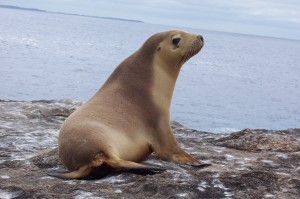What better way to kick off 2010 than with a post about the Australian sea lion, “one of the world’s rarest and most unusual seals?” A direct quote from the Encyclopedia of Marine Mammals. Although, technically a sea lion is not a true seal.
Seals and sea lions both belong to the scientific suborder Pinnipedia and as a result both are pinnipeds, but because sea lions have ear flaps they are not considered “true seals.” Now what is the big deal about ear flaps you ask? Excellent question and one I hope to learn the answer to in the encyclopedia article on pinnipeds in the “P” section. Usually this ear-flap difference is presented as a simple fact, but there has to be more to the story, stay tuned…
But back to the main topic, Australian sea lions or Neophoca cinerea. Well, lucky for us the scientists studying Australian sea lions have been very thorough and there are all sorts of interesting details to share. For starters, Australian sea lions qualify as unusual because they have a sesquiennial reproductive cycle, meaning they reproduce every year and a half or about every 17.5 months.
Similar to the Antarctic fur seal, Australian sea lions mate creating the early stage fetus called a blastocyst that doesn’t take hold within the uterus until 3.5 to 5 months later. This delay allows females to synchronize to the 17.5 month schedule. According to the Encyclopedia of Marine Mammals, this longer cycle allows females to “nurture a developing fetus and growing pup while having to forage.” Basically, a 17.5 month turn around time lets female Australian sea lions have it all, raise kids while working full-time.
But there is another level to this 17.5 month timing. Australian sea lions live in separate colonies along the southern coast of Australia and each colony times their reproductive schedule differently so all the pups aren’t born at once. This allows sea lion colonies to practice socialism. They share the wealth of natural resources by not placing an extra burden on the ecosystem at any given time. (Interestingly enough, Australian sea lions also practice sequential polygyny, which means they mate with several females but only one at a time throughout the breeding season.)
Pups arrive with dark brown fur, which becomes a cream tan brown after their first molt. Females keep this coloring, but typically an adult male’s fur will become brownish-black. For size, females average 140 pounds and grow up to five feet while males average 440 pounds and reach close to seven feet in length.
Australian sea lions tend to be home bodies and stay with the same colonies and venture far only to find food. They enjoy eating cephalopods (squid, octopus), crustaceans (crab, lobster) and fish. Here’s an excellent description on how Australian sea lions take in a meal, “Large prey are generally seized in the mouth and shaken violently at the surface to remove cuttlefish bones, skin or skeletons before swallowing.” This sounds hard on the neck and also a good way to become dizzy.
Scientists even observed how long it takes for food to pass from one end of an Australian sea lion to the other. “Depending on size, experimental markers take from 5 to 48 hours to pass through the alimentary [digestive] tract.” This is serious dedication to the study of marine mammals, pretty awesome. Another fun fact is that Australian sea lions have several pebbles in their stomachs to assist with digestion.
Despite being hunted mercilessly during the late 1700s to the 1850s, the Australian sea lion is still here with an estimated population of close to 10,000. This is very small compared to most seal and sea lion populations, which typically range anywhere from 250,000 into the millions. The Australian government treats the Australian sea lion as threatened to ensure the animals receive proper protections.
Excellent work Australians, thanks for going the extra mile to protect the very cool and unusual Australian sea lion hanging out down-under.

The Australian Sea Lion reproduces at the same rate as many mid-20th Century Catholics. Unfortunately, my mom did not have an awesome blastocyst so that she could forage while I was gestating. Nor were we socialists, alas.
this is even more awesomer than elmo